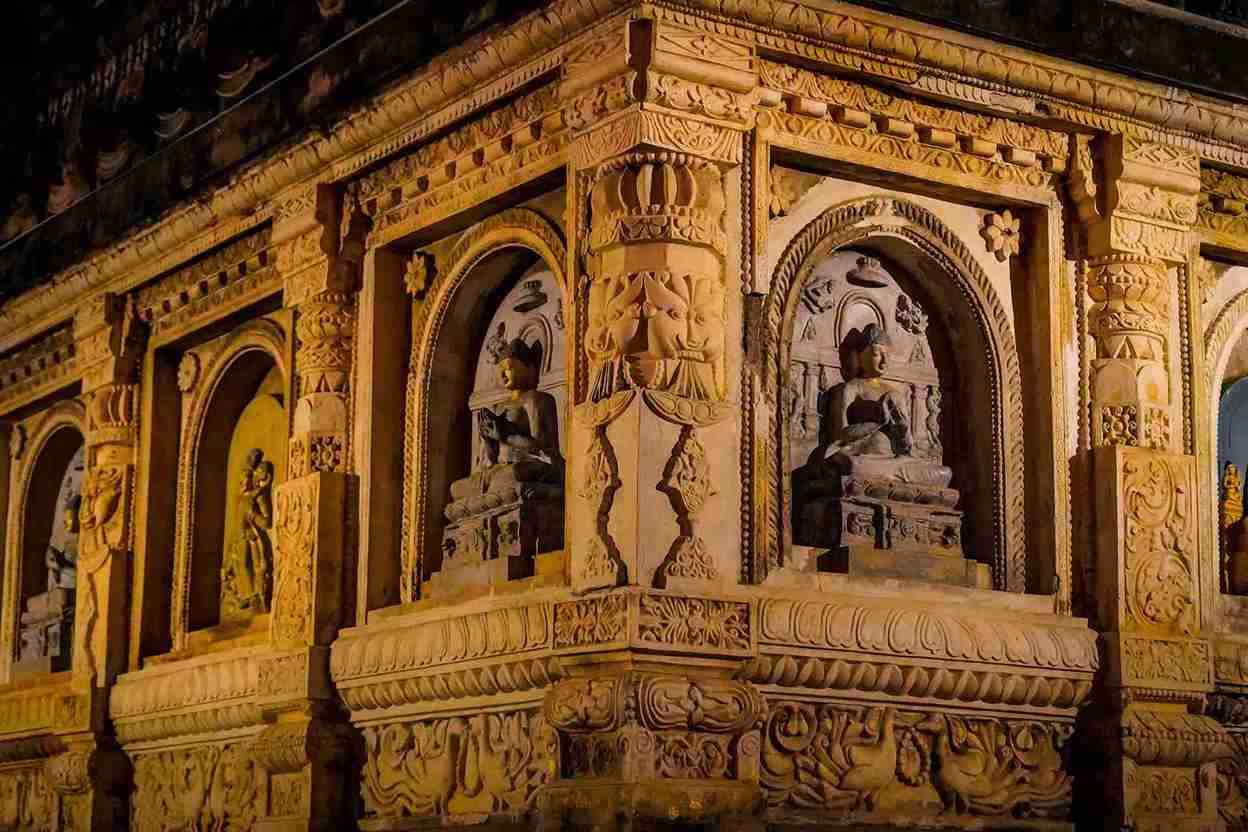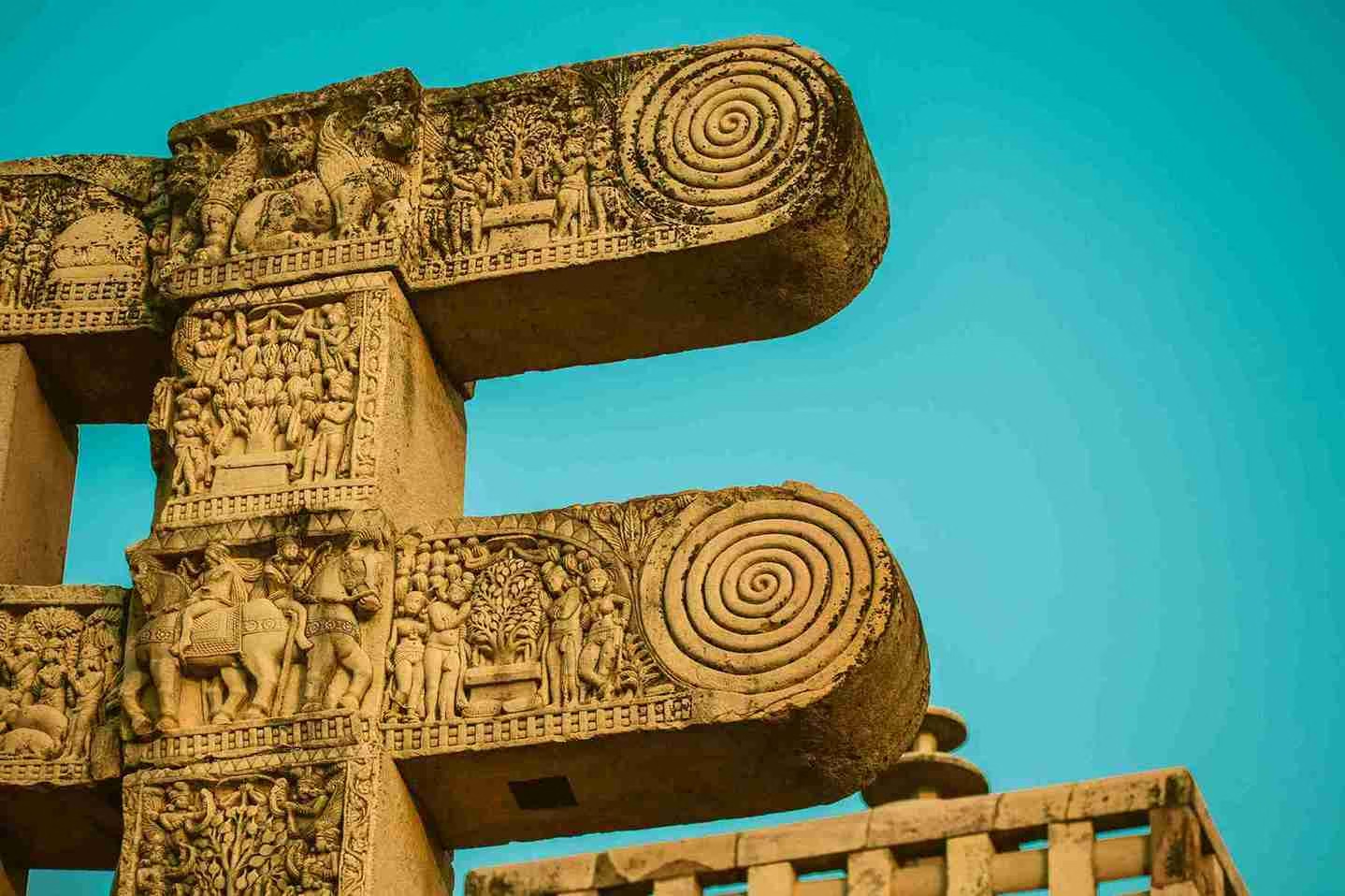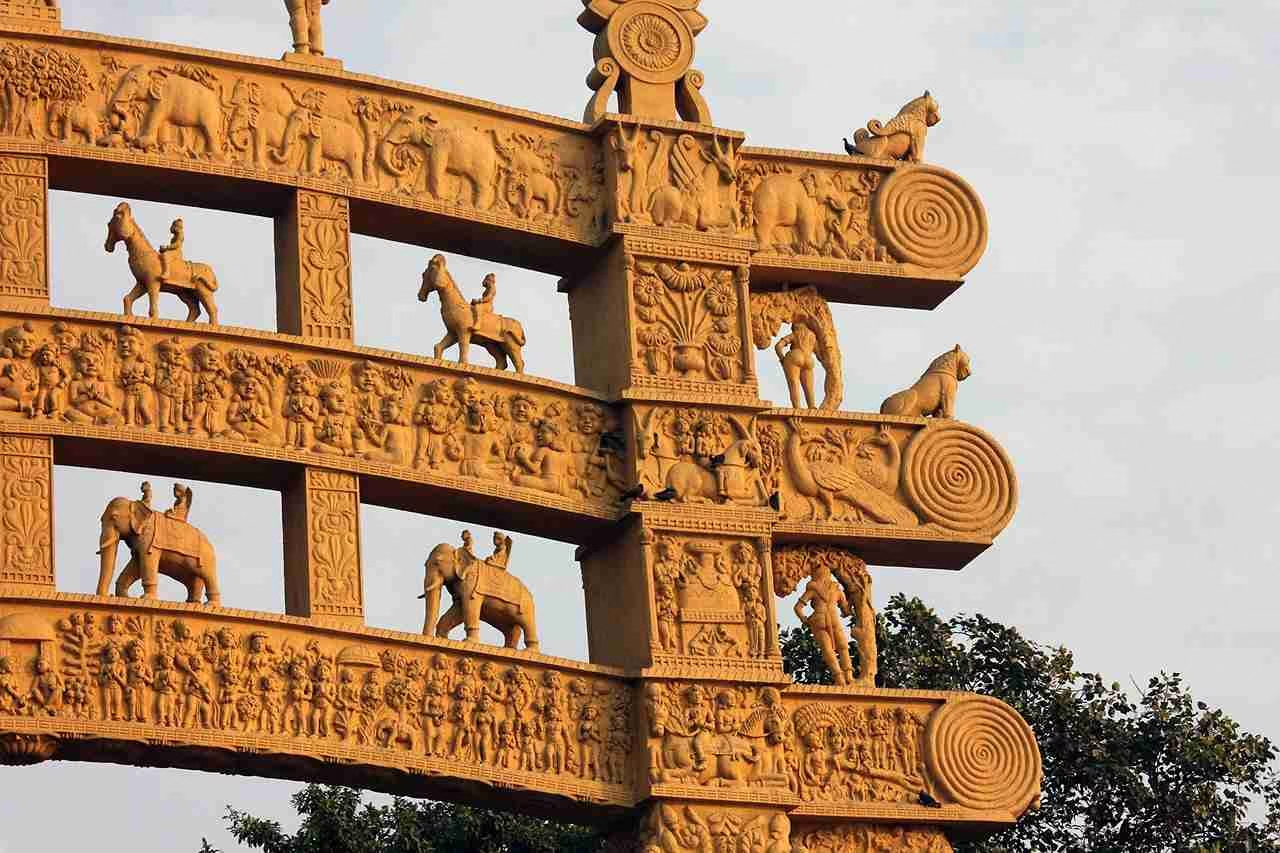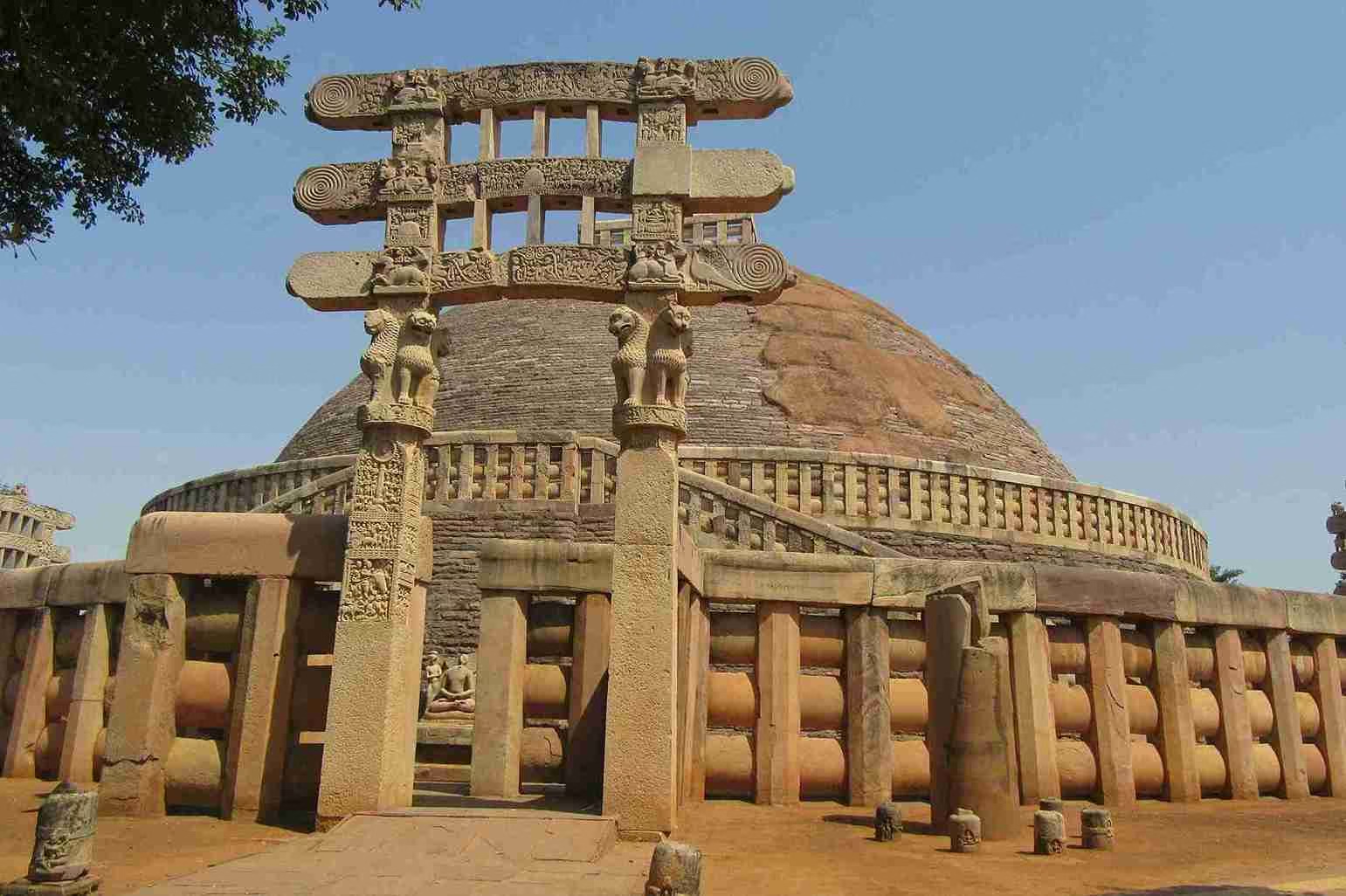Did you know the Sanchi Stupa in the Raisen district of Madhya Pradesh, India is the oldest stone structure in the country dating back to over 2,300 years ago? The Sanchi Stupa serves as a form to preserve the teachings imparted by Buddha. It was constructed after Buddha attained Nirvana, however, it has now become an important pilgrimage site!
Fasten your seatbelts and get ready, because this blog aims to take you on a journey to the Great Stupa at Sanchi! Through this blog, you will gain an insight into the history, architectural genius, and cultural as well as religious significance of the Sanchi Stupa. Without further delay, let’s dive right into our voyage!
The Sanchi Stupa which was built centuries ago is still considered a symbol of Buddhism and holds special importance in the Indian culture. It is not only a Buddhist monument and a world heritage site, there is more to it than the eyes meet. The great Stupa at Sanchi is a marvelous example of Indian architecture, with the gateways carved intricately and placed perfectly, piece by piece like a giant puzzle.
Did you also know that the great Stupa at Sanchi has a cameo in the MP tourism advertisement? The way it is depicted in the ad is just adorable!
What is the Historical Background of the Sanchi Stupa?
If you are also someone wondering who built the Stupa at Sanchi or why they built it? Keep reading ahead to find out!
The Stupa at Sanchi was built during the reign of the Mauryan Emperor Ashok to preserve the relics of Buddha and spread his teachings. It is a popular myth in the country that Ashok embraced Buddhism after he won at the Kalinga. So, there was a region called Kalinga, in present-day West Bengal, India, where Emperor Ashok went to battle. Although he won the war, he was left horrified at the sight of thousands of corpses around him. Hence, he decided to follow the path of Buddha and embraced non-violence or Ahimsa, as it was known in Prakrit or Ardhamagadhi, both are languages spoken during the Mauryan period.
After Emperor Ashok started following the path laid by Buddha, he built several monuments and shrines to spread the teachings of Buddha. Some of the famous monuments established by him include not only the Sanchi Stupa but also the Dhamek Stupa in Sarnath, Uttar Pradesh, the Mahabodhi Temple in Bodh Gaya, Bihar, the Barabar Caves again in Bihar, the Ashokan Pillars at various places like Vaishali, Sarnath, Rampurva, etc. All of these structures significantly contributed to the stretch of Buddhism all over Southeast Asia.

The Sanchi Stupa was originally constructed by emperor Ashok, however, it was damaged later but was restored by the later dynasties such as the Shunga dynasty and the Satavahana dynasty. It was not only repaired but also expanded by the Shungas. Nevertheless, it was under Emperor Ashoka’s patronage that the Sanchi Stupa came to be regarded as a centre for learning. It also led to the establishment of many monasteries for the Buddhist monks to stay and study.
The Architectural Brilliance of the Great Stupa at Sanchi.
Speaking of the Great Stupa at Sanchi, now that we have discussed the historical background of the Stupa, let us also take a look at the architectural brilliance, too.
The great stupa at Sanchi has many architectural features that you would definitely want to know. It comprises a dome, a few gateways, and also a railing. Let’s discuss each of these features in detail.
The dome, which is also known as an Anda, is one of the main attractions of the stupa. This dome is a symbol of the dome of heaven and also signifies Mount Meru. We will talk about the complete structure surrounding the dome in the next segment. However, right now as we take a look at the characteristic feature of the dome, it seems to signify the eternal nature of the universe and also hints at the concept of enlightenment in Buddhist philosophy.
The next most important feature that cannot be missed is the gateway. The great stupa has around four gateways, also known as Toranas in the common language spoken around. It is built at the cardinal points, which simply meaning the four main directions, i.e.. to the East, West, North, and South of the stupa. Every one of them is adorned with carvings- intricate and beautiful, that portray the life lived by Buddha. The four gateways serve as relic that depict the four stages of his life. The one in the East shows Buddha’s birth, the Western gateway reflects his first sermon or preaching, the Southern gateway shows his enlightenment, and the Northern gateway depicts his nirvana.

Every aspect of the great stupa has a different story to tell. Everything is carefully considered and constructed. Hence, it holds a purpose, meaning, and a charm. The railings at the stupa, also known as Harmika, hold a significant meaning. It is a square railing on top of the dome-like structure and is said to represent the abode of Gods. The Harmika has a central pole that is called a Yasti. This Yasti depicts the centre or axis of the Universe. It is also topped with an umbrella-like structure, known as a Chatra. This Chatra not only represents the highest rank in Buddhism, but it also signifies protection and honour.
Not just these, there are also the Ashokan Pillars that bear geometrical patterns and floral motifs. All in all, it can be said that the Sanchi Stupa is a timeless and classic example of Buddhist architecture, with every aspect screaming for elegance and wisdom that transcends the physicality of the structure. It serves as an embodiment of the path towards enlightenment.
Learn About Buddhist Iconography in Stone
In this blog, till now we have seen the architectural significance of the great stupa at Sanchi, Madhya Pradesh. Let us also learn about what is iconography, particularly Buddhist iconography, and how it is effectively used in stone at Sanchi.
The first question that comes to mind is what is iconography? The answer is that Iconography is the effective use of symbols, imagery, icons, and figures to portray certain themes or ideas. As the name suggests, iconography is a way to communicate the meaning or purpose of the piece of art through images rather than telling, it’s more about showing. Every culture, religion, region, and era has its iconography that is unique to them.
The next question that should essentially strike you is what does iconography indicate? And to simply answer your question, iconography reveals the nuances of the art form, along with showing the real meaning behind it. In many cultures, iconography may also help to determine Gods and deities through animated representations.
Now, coming back to the point of our discussion, see how it all goes in circles. That is what the Buddhist philosophy is all about, breaking free from this circle of life and attaining nirvana! Interesting, isn’t it?

Now, you might wonder what is Buddhist Iconography. Let me make it clear to you! Buddhist iconography is the depiction of themes, deities, symbols, motifs, analogies, and images prevalent in Buddhism. These are represented or conveyed through different art forms, such as sculptures, paintings, carvings, etc. The Buddhist iconographies include the illustrations of Bodhisattvas, narratives from the life of Buddha, and motifs like the Tree of Life, the Bodhi Tree, the Lotus Throne, the Dharma Chakra and the different hand gestures also known as mudras.
Have you watched the famous movie Kung Fu Hustle? If you have, you might know that the Buddha Palm makes a cameo in it!
Not just these, we should also consider the use of colours in Buddhist iconography. Colours play an important role in igniting certain emotions and making us feel a certain way. The colours, golden and yellow are highly used in Buddhism as a symbol of Earth.
From the earliest of times, aniconic forms were used to depict Buddha. So, for instance, the Bodhi tree, or the Dharma Chakra were used as a symbol to show the life, teachings of Buddha and the philosophy preached in Buddhism. However, with time it evolved and now we see Buddha being illustrated in human form, as a complete figure with hand movements, or gestures that signify or pass a message of peace, non-violence, etc. These are some of the changes that have occurred throughout time. The origin of these is still a topic of debate, however, the iconic form was developed and is seen in the Gandhara as well as Mathura style of architecture.
What is the Cultural and Religious Significance of the Sanchi Stupa?
In this section of the blog, let us unravel the answers to questions like how the great Stupa at Sanchi reflect the values of peace and Dharma, and how it has influenced Hindu temple designs and also Buddhist architecture.
The great stupa at Sanchi mirrors the Buddhist values of peace and dharma through its architecture, structure of the stupa, and its design. The Sanchi Stupa is an embodiment of the cycle of life, and the quest for enlightenment in its entirety. The dome, as we have discussed above, is a representation of the universe, the intricacy of the carvings depicts the story of Gautam Buddha’s life before and after he attained Nirvana. It gives the message of following one’s dharma. His teachings on peace, non-violence, and dharma, all together create a path for spiritual growth.
The dome has a circular shape with a portrayal of the cycle of life, meaning the cycle of life, death, and rebirth. This idea of life going in circles (quite literally!) focuses on the Buddhist philosophy of reincarnation and life after death, which is also a popular belief in many other cultures.
The other structures also signify something or the other. The central axis reflects the goal of attaining peace within oneself and liberating oneself from materialistic approaches, and earthly sufferings. The great stupa at Sanchi has also become a famous and consequential site for Buddhist scholars, who come and connect with the teachings of Buddha.

End Note
Coming to the end of this blog, I hope this blog has shed some light and has helped on your quest to find more about the Sanchi Stupa.
The Sanchi Stupa or as it is popularly known as the Great Stupa of Sanchi was rediscovered and restored in the 19th century by the Archaeological Survey of India. Since then the ASI has made efforts to maintain the stone structures, it carries out maintenance services at regular intervals to manage the Stupa, reduce damages and repair the structures.
The architecture of the Great Stupa at Sanchi has highly influenced the Hindu temple designs as well as the architecture of modern-day buildings, such as the Rashtrapati Bhavan. The architecture was so phenomenal that it influenced the design of other Stupas, Viharas, and Chaityas.
The Stupa at Sanchi, Madhya Pradesh, India has proved to be of relevance in the present times, too. It has been declared as a UNESCO World Heritage Site. the timeless beauty of the Stupas still charms millions of visitors globally. The Sanchi Stupa features a number of other Buddhist monuments such as a few monasteries, the Ashoka Pillar, two other stupas along with the great stupa, and temples. With easy commutation and airports nearby, there is a heavy footfall seen at the site. The Sanchi Stupa has become a tourist attraction.
For further reading, you can visit these useful resources:
Check out our Blog Page on Traditional Indian art.



Leave a Reply